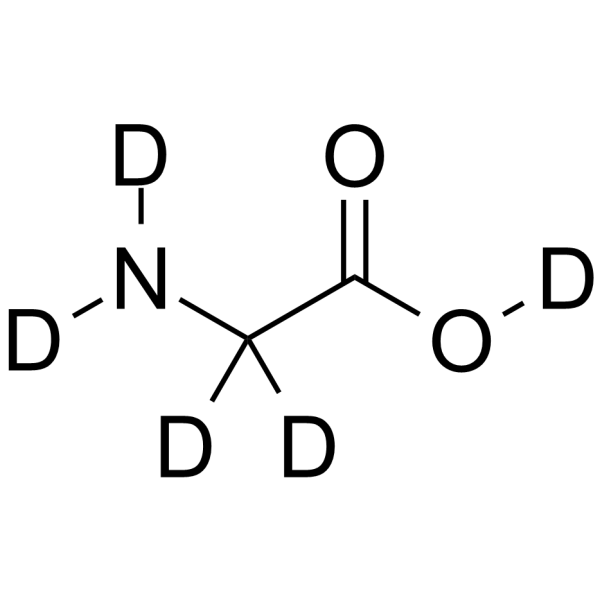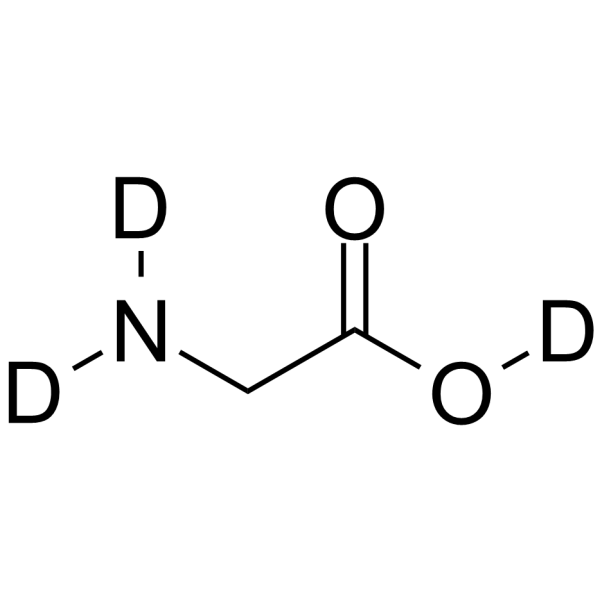Glycine-d5

Glycine-d5 structure
|
Common Name | Glycine-d5 | ||
|---|---|---|---|---|
| CAS Number | 4896-77-9 | Molecular Weight | 80.097 | |
| Density | 1.3±0.1 g/cm3 | Boiling Point | 240.9±23.0 °C at 760 mmHg | |
| Molecular Formula | C2D5NO2 | Melting Point | 240ºC (dec.)(lit.) | |
| MSDS | Chinese USA | Flash Point | 99.5±22.6 °C | |
Use of Glycine-d5Glycine-d5 is the deuterium labeled Glycine. Glycine is an inhibitory neurotransmitter in the CNS and also acts as a co-agonist along with glutamate, facilitating an excitatory potential at the glutaminergic N-methyl-D-aspartic acid (NMDA) receptors. |
| Name | deuterio 2,2-dideuterio-2-(dideuterioamino)acetate |
|---|---|
| Synonym | More Synonyms |
| Description | Glycine-d5 is the deuterium labeled Glycine. Glycine is an inhibitory neurotransmitter in the CNS and also acts as a co-agonist along with glutamate, facilitating an excitatory potential at the glutaminergic N-methyl-D-aspartic acid (NMDA) receptors. |
|---|---|
| Related Catalog | |
| In Vitro | Stable heavy isotopes of hydrogen, carbon, and other elements have been incorporated into drug molecules, largely as tracers for quantitation during the drug development process. Deuteration has gained attention because of its potential to affect the pharmacokinetic and metabolic profiles of drugs[1]. |
| References |
| Density | 1.3±0.1 g/cm3 |
|---|---|
| Boiling Point | 240.9±23.0 °C at 760 mmHg |
| Melting Point | 240ºC (dec.)(lit.) |
| Molecular Formula | C2D5NO2 |
| Molecular Weight | 80.097 |
| Flash Point | 99.5±22.6 °C |
| Exact Mass | 80.063416 |
| PSA | 63.32000 |
| LogP | -1.03 |
| Vapour Pressure | 0.0±1.0 mmHg at 25°C |
| Index of Refraction | 1.461 |
| Storage condition | 2-8°C |
Synonym:None Section 2 - COMPOSITION, INFORMATION ON INGREDIENTS
Risk Phrases: None Listed. Section 3 - HAZARDS IDENTIFICATION EMERGENCY OVERVIEW
The toxicological properties of this material have not been fully investigated.Hygroscopic (absorbs moisture from the air). Potential Health Effects Eye: Contact may cause transient eye irritation. The toxicological properties of this material have not been fully investigated. Skin: May cause skin irritation. Low hazard for usual industrial handling. The toxicological properties of this material have not been fully investigated. Ingestion: Ingestion of large amounts may cause gastrointestinal irritation. Low hazard for usual industrial handling. The toxicological properties of this substance have not been fully investigated. Inhalation: May cause respiratory tract irritation. Low hazard for usual industrial handling. The toxicological properties of this substance have not been fully investigated. Chronic: No information found. Section 4 - FIRST AID MEASURES Eyes: Flush eyes with plenty of water for at least 15 minutes, occasionally lifting the upper and lower eyelids. Get medical aid. Skin: Flush skin with plenty of water for at least 15 minutes while removing contaminated clothing and shoes. Get medical aid if irritation develops or persists. Wash clothing before reuse. Ingestion: Never give anything by mouth to an unconscious person. Do NOT induce vomiting. If conscious and alert, rinse mouth and drink 2-4 cupfuls of milk or water. Get medical aid if irritation or symptoms occur. Inhalation: Remove from exposure and move to fresh air immediately. If not breathing, give artificial respiration. If breathing is difficult, give oxygen. Get medical aid. Notes to Physician: Section 5 - FIRE FIGHTING MEASURES General Information: As in any fire, wear a self-contained breathing apparatus in pressure-demand, MSHA/NIOSH (approved or equivalent), and full protective gear. During a fire, irritating and highly toxic gases may be generated by thermal decomposition or combustion. Extinguishing Media: Use agent most appropriate to extinguish fire. Do NOT get water inside containers. Use water spray, dry chemical, carbon dioxide, or appropriate foam. Section 6 - ACCIDENTAL RELEASE MEASURES General Information: Use proper personal protective equipment as indicated in Section 8. Spills/Leaks: Vacuum or sweep up material and place into a suitable disposal container. Clean up spills immediately, observing precautions in the Protective Equipment section. Avoid generating dusty conditions. Provide ventilation. Do not get water inside containers. Section 7 - HANDLING and STORAGE Handling: Wash thoroughly after handling. Use with adequate ventilation. Minimize dust generation and accumulation. Avoid breathing dust, vapor, mist, or gas. Avoid contact with eyes, skin, and clothing. Keep container tightly closed. Avoid ingestion and inhalation. Do not allow contact with water. Keep from contact with moist air and steam. Storage: Keep under a nitrogen blanket. Store in a cool, dry, well-ventilated area away from incompatible substances. Store protected from moisture. Section 8 - EXPOSURE CONTROLS, PERSONAL PROTECTION Engineering Controls: Facilities storing or utilizing this material should be equipped with an eyewash facility and a safety shower. Use adequate ventilation to keep airborne concentrations low. Exposure Limits CAS# 4896-77-9: Personal Protective Equipment Eyes: Wear appropriate protective eyeglasses or chemical safety goggles as described by OSHA's eye and face protection regulations in 29 CFR 1910.133 or European Standard EN166. Skin: Wear appropriate protective gloves to prevent skin exposure. Clothing: Wear appropriate protective clothing to prevent skin exposure. Respirators: Follow the OSHA respirator regulations found in 29 CFR 1910.134 or European Standard EN 149. Use a NIOSH/MSHA or European Standard EN 149 approved respirator if exposure limits are exceeded or if irritation or other symptoms are experienced. Section 9 - PHYSICAL AND CHEMICAL PROPERTIES Physical State: Crystalline powder Color: brown - white Odor: Not available. pH: Not available. Vapor Pressure: Not available. Viscosity: Not available. Boiling Point: Decomposes Freezing/Melting Point: 248 deg C dec Autoignition Temperature: Not available. Flash Point: Not available. Explosion Limits, lower: Not available. Explosion Limits, upper: Not available. Decomposition Temperature: > 248 deg C Solubility in water: Specific Gravity/Density: Molecular Formula: C2D5NO2 Molecular Weight: 80.11 Section 10 - STABILITY AND REACTIVITY Chemical Stability: Stable under normal temperatures and pressures. Conditions to Avoid: Incompatible materials, dust generation, moisture, excess heat, exposure to moist air or water. Incompatibilities with Other Materials: Oxidizing agents. Hazardous Decomposition Products: Nitrogen oxides, carbon monoxide, irritating and toxic fumes and gases, carbon dioxide. Hazardous Polymerization: Has not been reported Section 11 - TOXICOLOGICAL INFORMATION RTECS#: CAS# 4896-77-9 unlisted. LD50/LC50: Not available. Carcinogenicity: Glycine-D5 - Not listed by ACGIH, IARC, or NTP. Section 12 - ECOLOGICAL INFORMATION Section 13 - DISPOSAL CONSIDERATIONS Dispose of in a manner consistent with federal, state, and local regulations. Section 14 - TRANSPORT INFORMATION IATA Not regulated as a hazardous material. IMO Not regulated as a hazardous material. RID/ADR Not regulated as a hazardous material. Section 15 - REGULATORY INFORMATION European/International Regulations European Labeling in Accordance with EC Directives Hazard Symbols: Not available. Risk Phrases: Safety Phrases: S 24/25 Avoid contact with skin and eyes. S 28A After contact with skin, wash immediately with plenty of water. S 37 Wear suitable gloves. S 45 In case of accident or if you feel unwell, seek medical advice immediately (show the label where possible). WGK (Water Danger/Protection) CAS# 4896-77-9: No information available. Canada None of the chemicals in this product are listed on the DSL/NDSL list. CAS# 4896-77-9 is not listed on Canada's Ingredient Disclosure List. US FEDERAL TSCA CAS# 4896-77-9 is not listed on the TSCA inventory. It is for research and development use only. SECTION 16 - ADDITIONAL INFORMATION N/A |
| Safety Phrases | S24/25 |
|---|---|
| RIDADR | NONH for all modes of transport |
|
~% 
Glycine-d5 CAS#:4896-77-9 |
| Literature: Mueller, Carmen; Schajor, W.; Zimmermann, H.; Haeberlen, U. Journal of Magnetic Resonance (1969-1992), 1984 , vol. 56, # 2 p. 235 - 246 |
|
Characterisation of skin barrier function using bioengineering and biophysical techniques.
Pharm. Res. 32(2) , 445-57, (2015) To characterise skin barrier function in vivo at two distinct anatomic sites using minimally invasive bioengineering and biophysical tools.In healthy human volunteers, the quantities of stratum corneu... |
|
|
Quantitative detection of chemical compounds in human hair with coherent anti-Stokes Raman scattering microscopy.
J. Biomed. Opt. 14(4) , 044019, (2009) Coherent anti-Stokes Raman scattering (CARS) microscopy is used to determine the distribution and concentration of selected compounds in intact human hair. By generating images based on ratiometric CA... |
| Aciport-d5 |
| Glycosthene-d5 |
| perdeuterioglycine |
| 2,2,O-trideuterio-2-dideuterioamino-acetic acid |
| Glicoamin-d5 |
| (H)Glycine |
| Glycine-d5 |
| pentadeuterio-glycine |
| Pentadeuterio-glycin |
| Padil-d5 |
| Glycocoll-d5 |
| Aminoacetic Acid-d5 |
| Glycolixir-d5 |
| Glycine-d |
| MFCD00064427 |
| Gyn-Hydralin-d5 |
| EINECS 225-518-6 |

![Propanamide,N-[(1S,2R,3E,5E,7S,9E,11E,13S,15R,19R)-7,13-dihydroxy-1,4,10,19-tetramethyl-17,18-dioxo-16-oxabicyclo[13.2.2]nonadeca-3,5,9,11-tetraen-2-yl]-2-oxo- structure](https://image.chemsrc.com/caspic/138/23623-31-6.png) CAS#:23623-31-6
CAS#:23623-31-6![Propanamide,N-[(1S,2R,3E,5E,7S,9E,11E,13S,15R,19R)-13-(acetyloxy)-7-hydroxy-1,4,10,19-tetramethyl-17,18-dioxo-16-oxabicyclo[13.2.2]nonadeca-3,5,9,11-tetraen-2-yl]-2-oxo-,(2S)- structure](https://image.chemsrc.com/caspic/451/23477-98-7.png) CAS#:23477-98-7
CAS#:23477-98-7 CAS#:1664-98-8
CAS#:1664-98-8 CAS#:124-38-9
CAS#:124-38-9